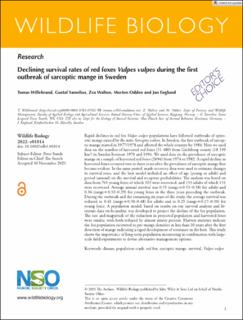Declining survival rates of red foxes Vulpes vulpes during the first outbreak of sarcoptic mange in Sweden
Peer reviewed, Journal article
Published version
Permanent lenke
https://hdl.handle.net/11250/2999985Utgivelsesdato
2021Metadata
Vis full innførselSamlinger
Originalversjon
10.1002/wlb3.01014Sammendrag
Rapid declines in red fox Vulpes vulpes populations have followed outbreaks of epizootic mange caused by the mite Sarcoptes scabiei. In Sweden, the first outbreak of sarcoptic mange started in 1977/1978 and affected the whole country by 1984. Here we used data on the number of harvested red foxes (51 480) from Gävleborg county (18 199 km2) in Sweden between 1970 and 1994. We used data on the prevalence of sarcoptic mange in a sample of harvested red foxes (2694) from 1974 to 1982. A rapid decline in harvested foxes occurred two to three years after the prevalence of sarcoptic mange first became evident. In the same period, mark–recovery data were used to estimate changes in survival rates, and the best model included an effect of age (young or adult) and period (annual) on the survival and recapture probabilities. The analysis was based on data from 701 young foxes of which 523 were recovered, and 133 adults of which 131 were recovered. Average annual survival was 0.55 (range = 0.53–0.58) for adults and 0.36 (range = 0.32–0.39) for young foxes in the three years preceding the outbreak. During the outbreak and the remaining six years of the study, the average survival was reduced to 0.41 (range = 0.30–0.48) for adults and to 0.25 (range = 0.17–0.30) for young foxes. A population model, based on results on our survival analysis and literature data on fecundity, was developed to project the decline of the fox population. The rate and magnitude of the reduction in projected population and harvested foxes were similar, with both reduced by almost ninety percent. Harvest statistics indicate the fox population recovered to pre-mange densities in less than 10 years after the first detection of mange indicating a rapid development of resistance in the host. This study shows the importance of long-term population monitoring in combination with large-scale field-experiments to devise alternative management options.

